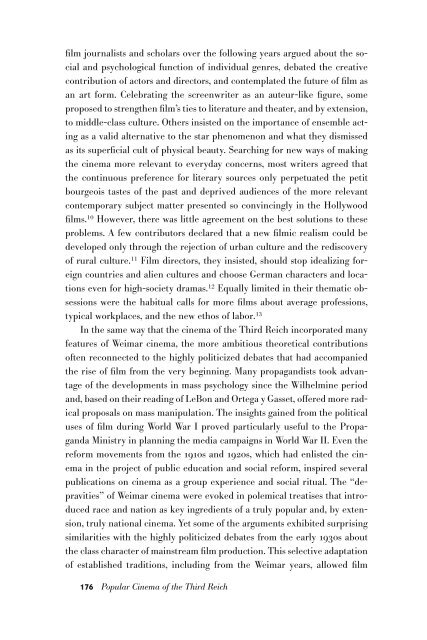You also want an ePaper? Increase the reach of your titles
YUMPU automatically turns print PDFs into web optimized ePapers that Google loves.
film journalists and scholars over the following years argued about the social<br />
and psychological function of individual genres, debated the creative<br />
contribution of actors and directors, and contemplated the future of film as<br />
an art form. Celebrating the screenwriter as an auteur-like figure, some<br />
proposed to strengthen film’s ties to literature and theater, and by extension,<br />
to middle-class culture. Others insisted on the importance of ensemble acting<br />
as a valid alternative to the star phenomenon and what they dismissed<br />
as its superficial cult of physical beauty. Searching for new ways of making<br />
the cinema more relevant to everyday concerns, most writers agreed that<br />
the continuous preference for literary sources only perpetuated the petit<br />
bourgeois tastes of the past and deprived audiences of the more relevant<br />
contemporary subject matter presented so convincingly in the Hollywood<br />
films. 10 However, there was little agreement on the best solutions to these<br />
problems. A few contributors declared that a new filmic realism could be<br />
developed only through the rejection of urban culture and the rediscovery<br />
of rural culture. 11 Film directors, they insisted, should stop idealizing foreign<br />
countries and alien cultures and choose German characters and locations<br />
even for high-society dramas. 12 Equally limited in their thematic obsessions<br />
were the habitual calls for more films about average professions,<br />
typical workplaces, and the new ethos of labor. 13<br />
In the same way that the cinema of the Third Reich incorporated many<br />
features of Weimar cinema, the more ambitious theoretical contributions<br />
often reconnected to the highly politicized debates that had accompanied<br />
the rise of film from the very beginning. Many propagandists took advantage<br />
of the developments in mass psychology since the Wilhelmine period<br />
and, based on their reading of LeBon and Ortega y Gasset, offered more radical<br />
proposals on mass manipulation. The insights gained from the political<br />
uses of film during World War I proved particularly useful to the Propaganda<br />
Ministry in planning the media campaigns in World War II. Even the<br />
reform movements from the 1910s and 1920s, which had enlisted the cinema<br />
in the project of public education and social reform, inspired several<br />
publications on cinema as a group experience and social ritual. The “depravities”<br />
of Weimar cinema were evoked in polemical treatises that introduced<br />
race and nation as key ingredients of a truly popular and, by extension,<br />
truly national cinema. Yet some of the arguments exhibited surprising<br />
similarities with the highly politicized debates from the early 1930s about<br />
the class character of mainstream film production. This selective adaptation<br />
of established traditions, including from the Weimar years, allowed film<br />
176 Popular Cinema of the Third Reich

















